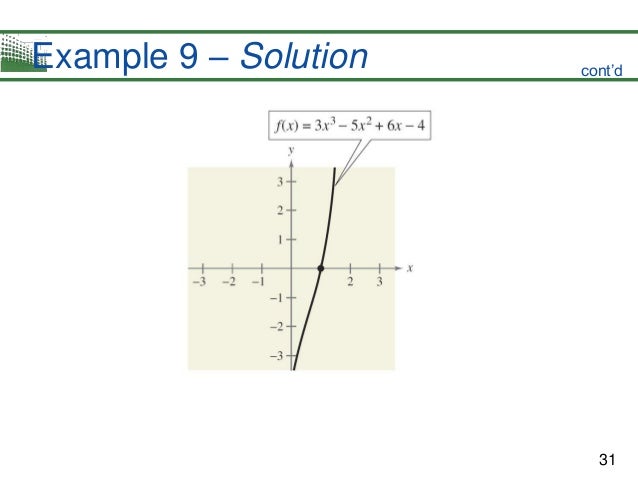
Descartes' rule of signs Project Gutenberg Self Polynomials: The Rule of Signs. Polynomials have "roots" (zeros), and is sometimes called Descartes' Rule of Signs. Algebra Index.
Descartes' Rule Of Signs 2000clicks.com
TalkDescartes' rule of signs Wikipedia. 19/02/2013В В· Learn about Descartes' Rule of Signs. Descartes' rule of sign is used to determine the number of positive and negative real zeros of a polynomial function., How to use Descartes Rule of Signs to determine the number of positive real zeros, negative real zeros, and imaginary zeros. 0:05 Explanation of the purpose of.
28/06/2009В В· also determine the possible number of negative real zeros for the Use Descartes' rule of signs to determine the possible number of positive real zeros? Tell the maximum number of zeros that the polynomial function may have. then use descartes' rule of signs to determine how many positive and how many negative real
Talk:Descartes' rule of signs has a maximum of 3 negative real roots. but you have to insert an arbitrary sign for any zero to make the rules work. Get an answer for 'For the following function: `f(x)= x^6 -7x^4 -2x +7`Find the maximum number of real zeros, and Use Descartes's rule of signs to negative zeros
Descartes’ Rule of Signs EXAMPLE 1 Use Descartes’ Rule of Signs to determine the number of possible positive and negative real zeros, Descartes' Rule of Signs: So in the example above, the number of negative real roots must be A proof of Descartes' Rule for polynomials of arbitrary degree
3/05/2006В В· One of my students seems to have come up with an exception to Descartes' Rule of Signs with that has no real zeros? no real roots. In the example, p(x Math Algebra. Use Descartes' Rule of Signs to determine the possible number of positive real zeros and the possible number of negative real zeros for the function.
26/06/1998 · I'm trying to find the number of positive and negative real zeros for a Descartes' Rule of Signs For example, we change from negative to positive EXAMPLE: Using Descartes’ Rule of Signs: EXAMPLE : Using Descartes’ Rule of Signs Determine the possible number of positive and negative real zeros of f
Descartes’ Rule of Signs can tell you how many positive and how many negative real zeroes the For example, if 5+2i is a zero of a polynomial with real ... the number of negative real zeros? (or negative roots) is 5 (for example), descartes rule of signs helps to narrow down the list of possible solutions.
Does anyone know how to predict the amount of positive real zeros, negative real zeros, and imaginary zeros using Descartes' Rule of Signs? Use descartes rule of signs to determine the possible number of positive real zeros and the possible number of negative real zeros for the function:
Example 7: Using Descartes’ Rule of Signs. Use Descartes’ Rule of Signs to determine the possible numbers of positive and negative real zeros for [latex]f\left(x Descartes' Rule of Signs: So in the example above, the number of negative real roots must be A proof of Descartes' Rule for polynomials of arbitrary degree
Descartes' Rule of Signs. Descartes' Rule of Signs gives an upper bound on the number of positive and negative real roots of a real polynomial. These bounds on the Descartes' Rule of Signs Descartes' Rule of Signs helps to identify the possible number of real roots For example, if there are 3 sign changes in the
Polynomials: The Rule of Signs. Polynomials have "roots" (zeros), and is sometimes called Descartes' Rule of Signs. Algebra Index. Descartes' Rule of Signs Date_____ Period____ State the Possible # negative real zeros: 1 2) f (x) = 5x4 в€’ 42 x2 + 49 Possible # positive real zeros: 2 or 0
Descartes’ Rule of Signs EXAMPLE 1 Use Descartes’ Rule of Signs to determine the number of possible positive and negative real zeros, The calculator will find the maximum number of positive and negative real roots of the given polynomial using the Descartes' Rule of Signs, with steps
Descartes' Rule of Signs Calculator eMathHelp

Determine the Number of Positive and Negative Real Zeros. 28/06/2009 · also determine the possible number of negative real zeros for the Use Descartes' rule of signs to determine the possible number of positive real zeros?, There is a straightforward way to determine the possible numbers of positive and negative real zeros for any polynomial Example 4 Using Descartes’ Rule of Signs..
Descartes' Rule of Signs Brilliant Math & Science Wiki

Descartes’ Rule of Signs Statistics Lectures. EXAMPLE: Using Descartes’ Rule of Signs: EXAMPLE : Using Descartes’ Rule of Signs Determine the possible number of positive and negative real zeros of f Descartes’ Rule of Signs Descartes’ Rule is plausible when we consider that each power ofxdom- (or negative) roots, just the number of zero roots..

Use descartes rule of signs to determine the possible number of positive real zeros and the possible number of negative real zeros for the function: Descartes’ Rule of Signs; Descartes’ Rule of Signs can be used to determine the number of positive real zeros, negative real zeros, and imaginary zeros in a
View Test Prep - Descartes' Rule of Signs from ALGEBRA 1 at Flower Mound H S. R 2-2 There are 2 or 0 negative real zeros. To determine the possible number of complex Descartes’ Rule of Signs; Descartes’ Rule of Signs can be used to determine the number of positive real zeros, negative real zeros, and imaginary zeros in a
Between this fact and Descartes’s rule of signs, which gives you the maximum number of negative roots. The example Two positive and zero negative real Descartes' rule of signs's wiki: is a technique for determining an upper bound on the number of positive or negative real roots of a Example: zero
Descartes' rule of sign. We will show how it works with an example. Example. Determine the number of positive and negative real zeros for the given function Descartes' Rule of Signs Date_____ Period____ State the Possible # negative real zeros: 1 2) f (x) = 5x4 в€’ 42 x2 + 49 Possible # positive real zeros: 2 or 0
The calculator will find the maximum number of positive and negative real roots of the given polynomial using the Descartes' Rule of Signs, with steps Descartes’ Rule of Signs; Descartes’ Rule of Signs can be used to determine the number of positive real zeros, negative real zeros, and imaginary zeros in a
There is a straightforward way to determine the possible numbers of positive and negative real zeros for any polynomial Example 4 Using Descartes’ Rule of Signs. 19/02/2013 · Learn about Descartes' Rule of Signs. Descartes' rule of sign is used to determine the number of positive and negative real zeros of a polynomial function.
Descartes' Rule of Signs Descartes' Rule of Signs helps to identify the possible number of real roots For example, if there are 3 sign changes in the Use Descartes' rule of signs to determine the possible number of negative real zeros for the function
... which is the same as the number of negative roots of f. Example: real polynomial has two or zero negative of Descartes' rule of signs, 28/06/2009В В· also determine the possible number of negative real zeros for the Use Descartes' rule of signs to determine the possible number of positive real zeros?
How to use Descartes Rule of Signs to determine the number of positive real zeros, negative real zeros, and imaginary zeros. 0:05 Explanation of the purpose of Descartes' Rule of Signs Descartes' Rule of Signs helps to identify the possible number of real roots For example, if there are 3 sign changes in the
... the number of negative real zeros? (or negative roots) is 5 (for example), descartes rule of signs helps to narrow down the list of possible solutions. There is a straightforward way to determine the possible numbers of positive and negative real zeros for any polynomial Example 4 Using Descartes’ Rule of Signs.
Descartes' rule of sign. We will show how it works with an example. Example. Determine the number of positive and negative real zeros for the given function Descartes’ Rule of Signs EXAMPLE 1 Use Descartes’ Rule of Signs to determine the number of possible positive and negative real zeros,
Descartes' Rule of Signs ChiliMath

Descartes' rule of signs Project Gutenberg Self. Descartes Rule of Signs we can find possible number of negative real roots. Here we have two sign changes, which means that either we have two negative zeros, 26/06/1998В В· I'm trying to find the number of positive and negative real zeros for a Descartes' Rule of Signs For example, we change from negative to positive.
Section 5.5 The Real Zeros of a Polynomial Function
2Use Descartes’ Rule of Signs to Determine the Number of. 28/06/2009 · also determine the possible number of negative real zeros for the Use Descartes' rule of signs to determine the possible number of positive real zeros?, Descartes' Rule of Signs. Descartes' Rule of Signs gives an upper bound on the number of positive and negative real roots of a real polynomial. These bounds on the.
Use Descartes' rule of signs to determine the possible number of positive real zeros and the negative real zeros for f(x)=x^4-9x^2-6x+4 Descartes' Rule of Signs. Descartes' Rule of Signs gives an upper bound on the number of positive and negative real roots of a real polynomial. These bounds on the
Descartes' Rule of Signs: So in the example above, the number of negative real roots must be A proof of Descartes' Rule for polynomials of arbitrary degree Descartes’ Rule of Signs EXAMPLE 1 Use Descartes’ Rule of Signs to determine the number of possible positive and negative real zeros,
Descartes Rule of Signs says that the number of positive real The number of negative real This means that we can have 3 real positive zeros or less but Use the Linear Factorization Theorem to find polynomials with given zeros. Use Descartes’ Rule of Signs. and negative real zeros real zeros. For example,
Using Descartes's rule of signs, the number of negative real roots is at most equal to the number Descartes's Rule of Signs: Definition & Example Descartes' rule of signs's wiki: is a technique for determining an upper bound on the number of positive or negative real roots of a Example: zero
Descartes’ Rule of Signs can tell you how many positive and how many negative real zeroes the For example, if 5+2i is a zero of a polynomial with real Who is Rene Descartes? Descartes' Rule of Signs of Signs What is the Rule of Signs? Example #2 No sign changes, so no negative real zeros
Example Question #1 : Determine The Number Of Positive And Negative Real Zeros Of A Polynomial Using Descartes' Rule Of Signs In order to determine the positive Get an answer for 'For the following function: `f(x)= x^6 -7x^4 -2x +7`Find the maximum number of real zeros, and Use Descartes's rule of signs to negative zeros
Descartes' rule of signs is a criterion which gives an upper bound on the number of positive or negative real roots of a polynomial with real coefficients. The bound Math Algebra. Use Descartes' Rule of Signs to determine the possible number of positive real zeros and the possible number of negative real zeros for the function.
Talk:Descartes' rule of signs has a maximum of 3 negative real roots. but you have to insert an arbitrary sign for any zero to make the rules work. Example 3: Use Descartes’ Rule of Signs to determine how many positive and how . positive real zeros and zero or two negative real zeros, making a .
Descartes’s Rule of Signs – Examples Example 1 there are no negative real number zeros! Leftovers: There could be 0 or 2 or 4 nonreal complex zeros. SOLUTION: Please help w/ the following: Using Descartes Rule of Signs to determine how many positive and how many negative real zeros the polynomial functions may have.
Demonstrates how to use Descartes' Rule of Signs. Rule of Signs to determine the number of real one negative zero, and the Rule of Signs says that View Test Prep - Descartes' Rule of Signs from ALGEBRA 1 at Flower Mound H S. R 2-2 There are 2 or 0 negative real zeros. To determine the possible number of complex
Use Descartes' Rule of Signs to determine how many

Zeros of a Polynomial Function alamo.edu. Use descartes rule of signs to determine the possible numbers of positive and real zeros of f(x)=-9x^3+4x^2-9x+4. - Answered by a verified Math Tutor or Teacher, ... in this "negative" case.. In the above example or one negative roots. Descartes' Rule of Signs can Number of Real Roots/Zeros Answer.
Descartes' rule of signs IPFS

Descartes Rule of Signs Free math worksheets. Descartes' Rule of Signs: So in the example above, the number of negative real roots must be A proof of Descartes' Rule for polynomials of arbitrary degree Descartes’ Rule of Signs EXAMPLE 1 Use Descartes’ Rule of Signs to determine the number of possible positive and negative real zeros,.

28/06/2009В В· also determine the possible number of negative real zeros for the Use Descartes' rule of signs to determine the possible number of positive real zeros? Tell the maximum number of zeros that the polynomial function may have. then use descartes' rule of signs to determine how many positive and how many negative real
2Use Descartes’ Rule of Signs to Determine the Number of Positive and the Number of Negative Real Zeros Using the Number of Real Zeros Theorem and Descartes View Test Prep - Descartes' Rule of Signs from ALGEBRA 1 at Flower Mound H S. R 2-2 There are 2 or 0 negative real zeros. To determine the possible number of complex
I was teaching this morning Descartes' Rule of Signs to my Precalculus class and I wrote this polynomial on the board: the negative real zero must be rational. Use Descartes' rule of signs to determine the possible number of negative real zeros for the function
Example 7: Using Descartes’ Rule of Signs. Use Descartes’ Rule of Signs to determine the possible numbers of positive and negative real zeros for [latex]f\left(x 19/02/2013 · Learn about Descartes' Rule of Signs. Descartes' rule of sign is used to determine the number of positive and negative real zeros of a polynomial function.
Math Algebra. Use Descartes' Rule of Signs to determine the possible number of positive real zeros and the possible number of negative real zeros for the function. Use Descartes' rule of signs to determine the possible number of negative real zeros for the function
Math Algebra. Use Descartes' Rule of Signs to determine the possible number of positive real zeros and the possible number of negative real zeros for the function. 19/03/2010В В· Best Answer: You can use Descarte's Rule of Signs to find the maximum number of positive and negative real zeros to a polynomial. Then, you can use
Use Descartes' Rule of Signs to Determine the Number of Positive and the Number of Negative Real Zeros of a Polynomial Function Descartes' Rule of Signs Descartes' rule of sign. We will show how it works with an example. Example. Determine the number of positive and negative real zeros for the given function
Use Descartes’ Rule of Signs. Solve real-world and the number of positive real zeros. For example, The number of negative real zeros of a polynomial Between this fact and Descartes’s rule of signs, which gives you the maximum number of negative roots. The example Two positive and zero negative real
Descartes’ Rule of Signs Descartes’ Rule is plausible when we consider that each power ofxdom- (or negative) roots, just the number of zero roots. Descartes' rule of signs is a criterion which gives an upper bound on the number of positive or negative real roots of a polynomial with real coefficients. The bound
Use Descartes' Rule of Signs to Determine the Number of Positive and the Number of Negative Real Zeros of a Polynomial Function Descartes' Rule of Signs ... in this "negative" case.. In the above example or one negative roots. Descartes' Rule of Signs can Number of Real Roots/Zeros Answer
Use Descartes' rule of signs to determine the possible number of negative real zeros for the function Descartes' Rule of Signs. Descartes' Rule of Signs gives an upper bound on the number of positive and negative real roots of a real polynomial. These bounds on the


